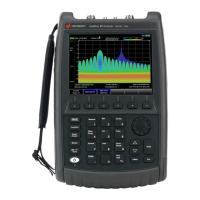284 Keysight N9938-90003 User’s Guide
Safety Considerations
For the AC/DC Adapter
For the AC/DC Adapter
Use only the designated AC/DC adapter supplied with the
instrument.
Use only the designated power cord supplied with the AC/DC
adapter.
Operated at an ambient temperature: 0 to 40°C; full power rating;
derate linearly at a rate of 3 watts per degree C, from 90W at 40°C
to 45W at 55°C, 30W at –20°C.
Input: 100-240 VAC, 1.5-0.75A, 50-60 Hz
Output: 15 VDC, 6A
To prevent electrical shock, disconnect the AC to DC adapter from
the mains before cleaning. Use a dry cloth or one slightly dampened
with water to clean the external case parts. Do not attempt to clean
internally.
When the FieldFox is connected to the AC/DC adapter, position the
adapter so the power cord is readily accessible. The power cord is
the disconnecting device. It removes main power to the AC/DC
adapter. The FieldFox front panel switch is only for the DC power
within the instrument, and not for the AC/DC adapter. Alternately,
an AC switch or circuit breaker (which is readily identifiable and is
easily reached by the operator) may be installed and used as a
disconnecting device to remove mains power from the AC/DC
adapter.
To avoid overheating, always disconnect the FieldFox from the
AC/DC adapter before storing the FieldFox in the backpack.
If you prefer to leave the FieldFox connected to the AC/DC adapter
while inside the backpack, you can disconnect the AC/DC adapter
from its AC power source to prevent overheating.
Safety of any system incorporating the equipment is the
responsibility of the assembler of the system.
This is a Safety Protection Class I Product (provided with a
protective earthing ground incorporated in the power cord). The
mains plug shall only be inserted in a socket outlet provided with a
protective earth contact. Any interruption of the protective
conductor inside or outside of the product is likely to make the
product dangerous. Intentional interruption is prohibited.

